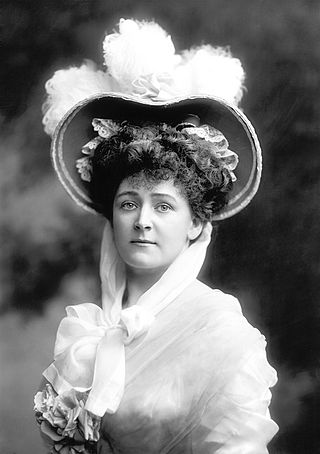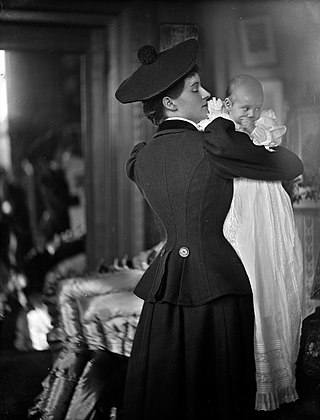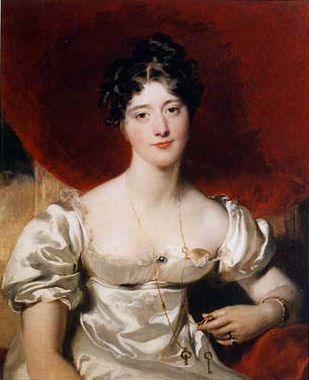
Lady Sarah Lennox was the most notorious of the famous Lennox sisters, daughters of Charles Lennox, 2nd Duke of Richmond and Sarah Cadogan.

Frances Evelyn "Daisy" Greville, Countess of Warwick was a British socialite and philanthropist. Although embedded in late-Victorian British high society, she was also a campaigning socialist, supporting many schemes to aid the less well-off in education, housing, employment, and pay, and was often known as the "Red Countess". She established colleges for the education of women in agriculture and market gardening, first in Reading, then in Studley. She established a needlework school and employment scheme in Essex as well as using her ancestral homes to host events and schemes for the benefit of her tenants and workers. Greville was a long-term confidant or mistress to the Prince of Wales, who later became King Edward VII.

Edith Helen Vane-Tempest-Stewart, Marchioness of Londonderry, DBE was a noted and influential society hostess in the United Kingdom between World War I and World War II, a friend of the first Labour prime minister, Ramsay MacDonald. She was a noted gardener and a writer and editor of the works of others.
Lady Alexandra Mary Cecilia Caroline Paget was an English socialite and actress.
George John Charles Mercer Nairne Petty-Fitzmaurice, 8th Marquess of Lansdowne, DL, was a British peer and Conservative politician.

Mount Stewart is a 19th-century house and garden in County Down, Northern Ireland, owned by the National Trust. Situated on the east shore of Strangford Lough, a few miles outside the town of Newtownards and near Greyabbey, it was the Irish seat of the Stewart family, Marquesses of Londonderry. Prominently associated with the 2nd Marquess, Robert Stewart, Viscount Castlereagh, Britain's Foreign Secretary at the Congress of Vienna and with the 7th Marquess, Charles Vane-Tempest-Stewart, the former Air Minister who at Mount Stewart attempted private diplomacy with Hitler's Germany, the house and its contents reflect the history of the family's leading role in social and political life in Britain and Ireland.

Beatrix Frances Beauclerk, Duchess of St Albans, Marchioness of Waterford, GBE, DGStJ, born Lady Beatrix Frances Fitzmaurice, was a member of the Anglo-Irish aristocracy, both by birth and through her two marriages.

Amelia Anne Stewart, Marchioness of Londonderry, nicknamed "Emily" and, from 1794 until 1821 generally known as Lady Castlereagh, was the wife of the Georgian-era Anglo-Irish statesman Robert Stewart, Viscount Castlereagh, who from 1812 to 1822 was British Foreign Secretary and Leader of the House of Commons. Well-connected by birth to the aristocracy and wife of a prominent politician who was Britain's leading diplomat during the close of the Napoleonic Wars, Lady Castlereagh was an influential member of Regency London's high society.

Sybil Rachel Betty Cecile Cholmondeley, Marchioness of Cholmondeley, styled Countess of Rocksavage from 1913 to 1923, was a British socialite, patron of the arts, and Chief Staff Officer in the Women's Royal Naval Service (WRNS) during the Second World War. She belonged to the prominent Sassoon and Rothschild families.

Elizabeth Conyngham, Marchioness Conyngham, was an English courtier and noblewoman. She is thought to be the last mistress of George IV of the United Kingdom.

Barbara Rawdon-Hastings, Marchioness of Hastings, 20th Baroness Grey de Ruthyn was a fossil collector and geological author.

George Thomas John Nugent, 1st Marquess of Westmeath, styled Lord Delvin between 1792 and 1814 and known as The Earl of Westmeath between 1814 and 1821, was an Anglo-Irish peer.

Frances Anne Vane, Marchioness of Londonderry was an Anglo-Irish heiress and noblewoman. She was the daughter of Sir Henry Vane-Tempest, 2nd Baronet. She married Charles William Stewart, 1st Baron Stewart. She became a marchioness in 1822 when Charles succeeded his half-brother as 3rd Marquess of Londonderry.

Henry Weysford Charles Plantagenet Rawdon-Hastings, 4th Marquess of Hastings and 9th Earl of Loudoun, styled Lord Henry Rawdon-Hastings from birth until 1851, was a British peer. He was also, starting from most senior barony, 21st Baron Grey of Ruthyn, 20th Baron Botreaux, 19th Baron Hungerford, and 17th Baron Hastings.
Emily Nugent, Marchioness of Westmeath, formerly Lady Emily Anne Bennet Elizabeth Cecil, was the first wife of George Nugent, 1st Marquess of Westmeath.
Georgiana Somerset, Marchioness of Worcester, formerly Georgiana Frederica Fitzroy, was the first wife of Henry Somerset, 7th Duke of Beaufort, but died prior to his inheriting the dukedom.
Sarah Rose Cholmondeley, Marchioness of Cholmondeley is a British peeress, former model, and former political staffer. She is married to David Cholmondeley, 7th Marquess of Cholmondeley.
Mary Watson-Wentworth, Marchioness of Rockingham was the wife of Charles Watson-Wentworth, 2nd Marquess of Rockingham, who was prime minister of Great Britain in 1782 and again from 1765 to 1766.
Bertha Lelgarde Clifton, 22nd Baroness Grey de Ruthyn was a British aristocrat.
Lady Anne Camilla Eveline "Micky" Nevill was a British aristocrat and confidante of Elizabeth II.












